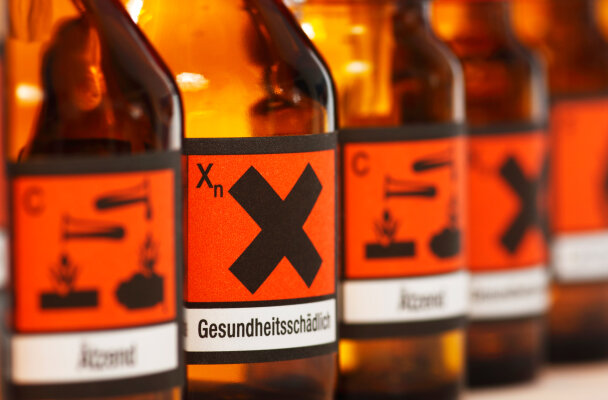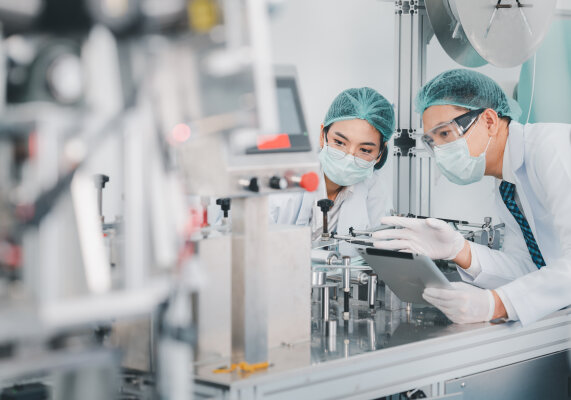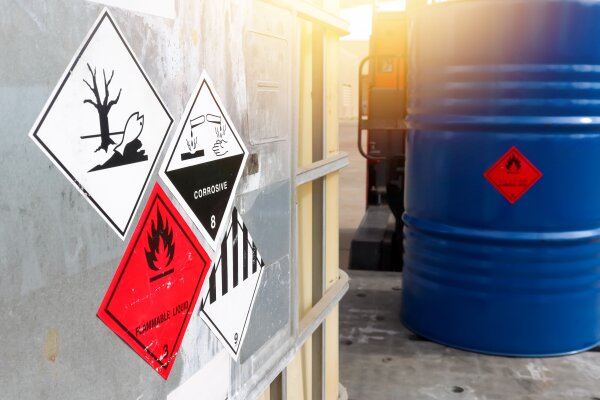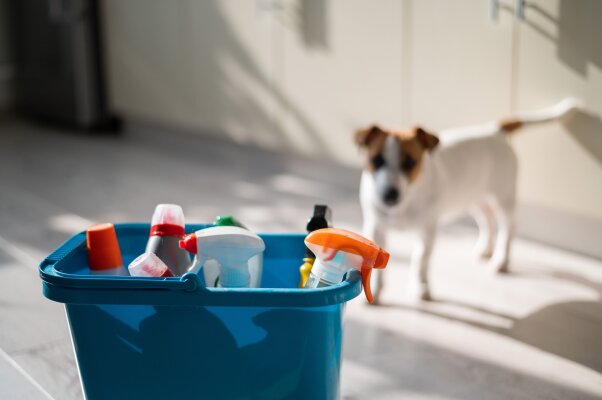Calibrate PH meter: Instruction
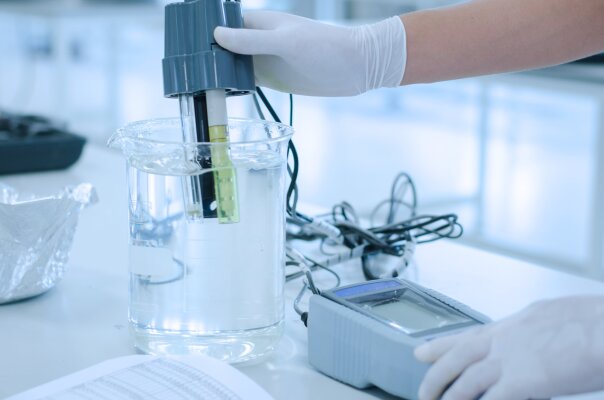
To determine the pH value of a solution, so-called pH meters or pH measuring instruments are used. These determine the value in an electrochemical manner, which is why they must be calibrated regularly. You can find out here which different devices are available, how you can calibrate a pH meter and what time interval you should pay attention to.
Calibrate various PH measuring instruments
Not all measuring instruments are the same: When it comes to determining the pH value,several variantsare possible. And the pH meter operation also plays a crucial role. Nowadays, pH meters with glass membranes or those with ion-sensitive field-effect transistors (ISFET) are particularly common.
Devices with glass membrane
These meters are widely used and can be found in chemical laboratories as well as in the food industry. They use the potential of a glass electrode, which is therefore also called a “pH electrode”. A half-cell reaction results in the formation of an electric potential, which is directly related to the H+ ion concentration present.
In addition,a reference electrode (usually a silver-silver chloride half cell) is connected to a combination electrode in the glass electrode. During the actual measurement, a loadable current is generated so that a voltage is produced from the potential difference to the reference electrode – the pH value can thus be mapped approximately linearly.
Before purchasing, however, it should be taken into account that the low loading capacity of the measuring potential allows a slight disturbanceof the measurement, which can happen, for example, due to flow potentials. Impurities and leaching also quickly lead to measurement errors.
Devices with ISFET
In contrast, newer measuring devices are based on an ISFET principle (ion-selective field-effect transistor). This pH meter mode of operation is based on an integrated electronic circuit, so the process is somewhat more stable and robust – thus, malfunctions can be better avoided. However, the service life of the sensor is lower, both in terms of durability and the number of measurement operations.
With regard to the possible areas of application and the calibration of the pH electrode, there are only marginal differencesbetween the two variants, so that the individual advantages and disadvantages should be weighed up. The ISFET devices are nowadays also found in industry, medicine and in swimming pools.
Calibrate pH meter: Instruction
The longer a pH meter is in use, the higher the probability that measurement errors will occur. This is simply due to the fact that the liquid contained in it ages and the degree of contamination increases continuously.
Sinceinaccurate readings would be disastrous in many industries, it is necessary to calibrate the pH tester – and that also means regular cleaning of the PH electrode. This is quite simple and differs only slightly between the devices in terms of procedures. The basic procedure is as follows:
- Adjust the temperature: It is important that the buffer solution and the instrument are at exactly the same temperature during calibration. This should ideally be achieved with an automatic temperature compensator.
- Check electrode:The first step is to check the electrode. If this is defective, it must be replaced.
- Preparation: If a new electrode is used, it must first be stored in a beaker with storage liquid for about four hours.
- Setting: The instrument must then be set from MTC (Manual Temperature Compensation) to “ATC” (Automatic Temperature Compensation) or “pH” so that it can operate automatically.
- Immerse electrode in pH 7.0: Next, place a clean electrode in a fresh buffer solution with a pH of 7.0. The reading of the pH meter must also be set to exactly 7.0. The voltage at this measuring point represents the baseline.
- Rinsing (single-point calibration): The first rinsing of the electrode with demineralized water follows. After that, the first part of the calibration – the so-called single-point calibration – is completed.
- Immerse the electrode in pH 4.0: The two-point calibration follows. To do this, the same electrode is now immersed in a buffer solution with a pH value of 4.0 (or optionally 10.0). Again, the correct reading must be set on the meter.
- Rinsing (two-point calibration):Finally, the electrode is rinsed a second time. After this, the two-point calibration is also completed and the pH meter is ready for use again, since two measuring points have been determined for the linear progression of the voltage.
Calibrate pH meter: digital and manual
In the case of pH meters, a further distinction is also possible – between digital and manual meters. Although they differ slightly in structure, there are only minimal differences in the respective calibration.
Digital pH meter
Digital pH meters are widely available and may differ not only in size and structure, but also in design and price. When it comes to calibration, however, all devices are similar, which makes the process easier. The probe at the end of the pH meter is simply dipped into the buffer solutions. The measurement takes place at the push of a button. It is important to set to “ATC” or “pH” beforehand.
Manual pH meter
Manual pH meters usually do not have a head that can be used to calibrate the pH electrode. Instead, a screw on the device must be loosened, which is located at the end of the pin. As soon as the measured value matches that of the solution, the measurement can be terminated and the screw tightened again.
Calibrate pH meter: Buffer solutions
Buffer solutions are required to calibrate a pH measuring instrument. These bear their name because they can both keep a pH stable and buffer it. These special solutions are standardized according to DIN 19266, which makes them easily reproducible. Uncertainties are a maximum of 0.005 pH units. When selecting and using buffer solutions, pay attention to the following factors:
- Order of use: In fact, it does not matter at all in which order the buffer solutions are used in a two-point calibration. The only important thing is that the voltage is determined at least twice. Whether the pH value 7.0 or 4.0 or 7.0 is used first is irrelevant.
- Composition: The composition is also specified in DIN 19266. According to this standard, a buffer solution consists of either:
- from a weak acid and a conjugate base
- OR from a weak base and a conjugate acid.
- Temperature: In addition, attention must be paid to the temperature of the buffer solution. The linear value is given for 25°C, so calibration of pH meters should also be performed at 25°C. If temperature differences occur, large errors in the measurement results are sometimes to be expected.
Calibration of the pH electrode with different methods
How to calibrate the pH value is specified in DIN 19269. Several procedures are also given there, according to which the process can be carried out. In addition to a single-point calibration, the two-point calibration described above and a multi-point calibration are also possible.
Single point calibration
In a so-called single-point calibration, only one buffer solution is used, and this is used to determine the zero point of the pH electrode. From there, the slope is assumed to be the same as the Nernst slope, which is the theoretical value of the electrode slope. Although this procedure is time-saving, it should only be used when several identical solutions are to be checked.
Two-point calibration
Two-point calibration is performed with the aid of two buffer solutions that differ in pH value. A linear slope and a zero pointcan be determined between the two measuring points, from which the output value of the pH electrode is calculated. Usually, this method is sufficient to calibrate the pH value and achieve a high measurement accuracy.
Multipoint calibration
It becomes even more specific with multipoint calibrations, which use several (mostly alkaline) buffer solutions as reference. The distance of the pH value between the individual solutions is 0.5 or more. Adjacent segments are formed within which the slope and zero point can be determined. This allows particularly accurate measured values to be achieved.
Is it important to calibrate the pH meter?
Although the terms “calibration” and “verification” are often used interchangeably, they are completely separate processes. Calibration should be carried out independently on a regular basis to enable permanently accurate measured values. Should inaccurate measurement results actually occur, this is in principle not associated with any legal consequences.
This is contrasted with the calibration of the pH meter, which must be performed by a specialist. During calibration, the device is tested in an official inspection to determine whether it meets the legal requirements. If this is not the case, it must not be used further.
How often do you have to calibrate the pH meter?
Unlike the buffer solution, there are no standards or legal requirements for the frequency of calibration. It makes sense to calibrate the pH tester regularly: This is the only way to prevent inaccurate measured values from arising and negatively affecting the quality of products or research results. Also, the durability of the gauges can sometimes be greatly shortened if this maintenance step is omitted.
The ideal time interval for recalibration depends on several factors. These include, for example, the frequency of use and the need for absolutely accurate readings. It is usually recommended to calibrate the pH meters at least twice a month. But daily cycles may also be appropriate.
In addition, the question “How often to calibrate the pH meter?” can be answered by referring to specific cases, i.e. when one or more of the following circumstances become noticeable:
- A new electrode is used or installed
- A few days have passed since the device was last used
- The existing electrode has just been cleaned
- A measurement was made in a strong (acidic or basic) solution
- The following measurement must have a particularly accurate result
Calibrate pH meters correctly and regularly
Calibrating the pH meter does not only result in high measuring accuracy: it also increases the durability, which is monetarily profitable. It is important to pay attention to a suitable procedure and to choose the right time intervals. Then nothing will stand in the way of optimum measured values with all device types.
FAQ
When calibrating the pH meter, two points are determined between which a linear voltage curve can be generated. This ensures that the output pH value is accurate again – and not incorrectly displayed due to aging liquids or contamination, for example.
Tocalibrate a pH meter, the electrode must first be immersed in a buffer solution with a pH value of 7.0 and then rinsed. These two steps are repeated and the second buffer solution must have a pH of 4.0 or 10.0.
The correct time interval depends on the extent of use and the need for absolutely accurate readings. Although calibration of the pH electrode should be performed at least twice a month, it is also possible to work with a short interval of one day.
pH meters must be calibrated regularly, which can be labor intensive. Since the procedure is quite simple in execution, it can (and may) be carried out in principle by any instructed employee.
Haben Sie Fragen zum Thema oder möchten Sie ein Thema vorschlagen? Please feel free to contact us by phone at +49 30 2096579 00 or send us an email to info@medsolut.com.

